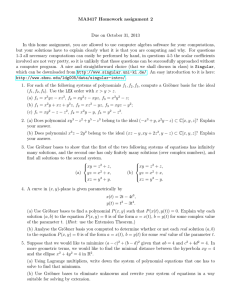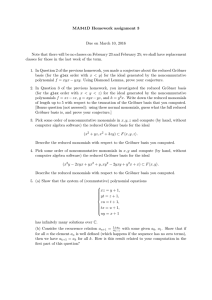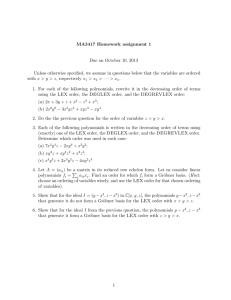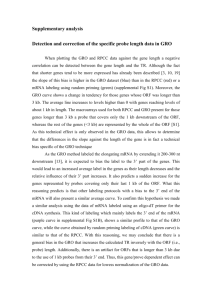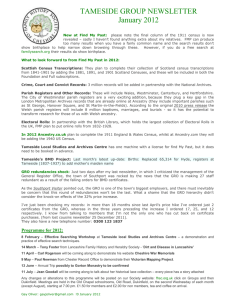341D: Gr¨ obner bases 1 / 22
advertisement
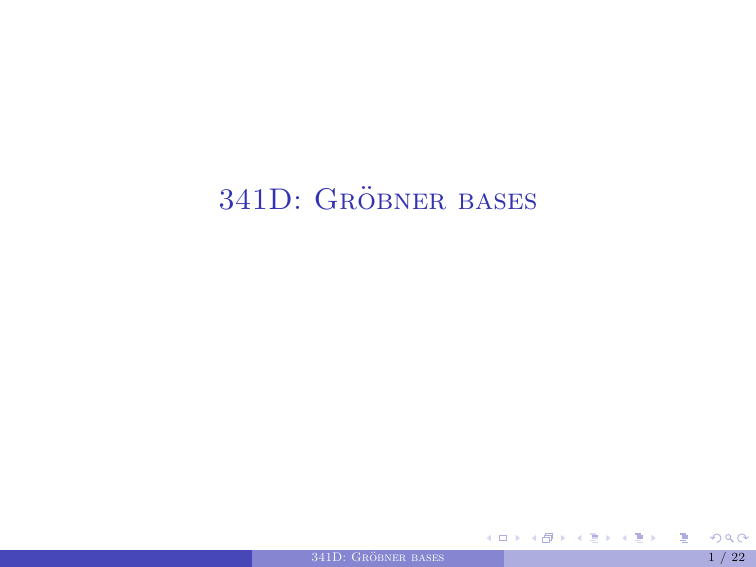
341D: Gröbner bases
341D: Gröbner bases
1 / 22
Implicitisation
A curve in (x, y )-plane is given parametrically by
x(t) = 2t − 4t 3 ,
y (t) = t 2 − 3t 4 .
Let us use Gröbner bases to find a polynomial P(x, y ) such that
P(x(t), y (t)) = 0.
341D: Gröbner bases
2 / 22
Implicitisation
To eliminate t from these parametric equations, we consider the lex
ordering with t > x > y , and compute a Gröbner basis of the ideal
I = (x − 2t + 4t 3 , y − t 2 + 3t 4 ); it is
2t 2 − 3tx + 4y ,
9tx 2 − 8ty − 2t − 12xy + x,
24txy − 2tx + 3x 2 − 32y 2 − 8y ,
192ty 2 + 32ty − 4t + 27x 3 − 120xy + 2x,
27x 4 − 144x 2 y − 4x 2 + 256y 3 + 128y 2 + 16y
so we may take P(x, y ) = 27x 4 − 144x 2 y − 4x 2 + 256y 3 + 128y 2 + 16y .
341D: Gröbner bases
3 / 22
Implicitisation
To eliminate t from these parametric equations, we consider the lex
ordering with t > x > y , and compute a Gröbner basis of the ideal
I = (x − 2t + 4t 3 , y − t 2 + 3t 4 ); it is
2t 2 − 3tx + 4y ,
9tx 2 − 8ty − 2t − 12xy + x,
24txy − 2tx + 3x 2 − 32y 2 − 8y ,
192ty 2 + 32ty − 4t + 27x 3 − 120xy + 2x,
27x 4 − 144x 2 y − 4x 2 + 256y 3 + 128y 2 + 16y
so we may take P(x, y ) = 27x 4 − 144x 2 y − 4x 2 + 256y 3 + 128y 2 + 16y .
Note that the Gröbner basis contains the element 2t 2 − 3tx + 4y where
the coefficient of the highest power of t is nonzero, so the Extension
Theorem guarantees that over an algebraically closed field any common
root (x, y ) of the elimination ideal I1 = (P(x, y )) extends to a root
(t, x, y ) of I , so we can guarantee that every complex solution corresponds
to some value of t.
341D: Gröbner bases
3 / 22
Implicitisation
Suppose that we look for that curve over the real numbers. Is it true that
every point corresponds to some value of the parameter t?
341D: Gröbner bases
4 / 22
Implicitisation
Suppose that we look for that curve over the real numbers. Is it true that
every point corresponds to some value of the parameter t?
The second element in the Gröbner basis is 9tx 2 − 8ty − 2t − 12xy + x, so
if some triple (t0 , x0 , y0 ) solves our equations, then
t0 (9x02 − 8y0 − 2) − 12x0 y0 + x0 = 0.
If 9x02 − 8y0 − 2 6= 0, we have
t=
12x0 y0 − x0
,
9x02 − 8y0 − 2
so if x0 and y0 are real, t0 is also real.
341D: Gröbner bases
4 / 22
Implicitisation
If 9x02 − 8y0 − 2 = 0, the equation
t0 (9x02 − 8y0 − 2) − 12x0 y0 + x0 = 0
1
. Substituting each of
also forces 12x0 y0 − x0 = 0, so x0 = 0 or y0 = 12
2
these into 9x0 − 8y0 − 2 = 0, we√get three pairs which we have to examine
1
more carefully: (0, − 14 ) and (± 32√23 , 12
). For those, we look at the first
element of the Gröbner basis, 2t 2 − 3tx + 4y . Substituting these pairs, we
obtain the polynomials
2t 2 − 1,
√
√
1
2 2
2t 2 + √ t + = (t 2 +
3
3
√
√
2 2
1
2t 2 − √ t + = (t 2 −
3
3
1
√ )2 ,
3
1
√ )2 .
3
All these polynomials have only real roots, so the corresponding values of t
are always real.
341D: Gröbner bases
5 / 22
Conditional extrema
Suppose that we would like to minimize (a − c)2 + (b − d)2 given that
ab = 4 and c 2 + 4d 2 = 4. In more geometric terms, we would like to find
the minimal distance between the hyperbola xy = 4 and the ellipse
x 2 + 4y 2 = 4 in R2 .
341D: Gröbner bases
6 / 22
Conditional extrema
Suppose that we would like to minimize (a − c)2 + (b − d)2 given that
ab = 4 and c 2 + 4d 2 = 4. In more geometric terms, we would like to find
the minimal distance between the hyperbola xy = 4 and the ellipse
x 2 + 4y 2 = 4 in R2 . The Lagrange multipliers method suggests that we
should look at the critical points of the function
F (a, b, c, d, α, β) = (a − c)2 + (b − d)2 − α(ab − 4) − β(c 2 + 4d 2 − 4).
We have
∂a F = 2(a − c) − αb,
∂b F = 2(b − d) − αa,
∂c F = 2(c − a) − 2βc,
∂d F = 2(d − b) − 8βd,
∂α F = ab − 4,
∂β F = c 2 + 4d 2 − 4.
Vanishing of these is precisely the system of equations we should solve.
341D: Gröbner bases
6 / 22
Conditional extrema
Computing a Gröbner basis for the LEX ordering with
α > β > a > b > c > d using Singular, we get a Gröbner basis
consisting of the elements
341D: Gröbner bases
7 / 22
Conditional extrema
Computing a Gröbner basis for the LEX ordering with
α > β > a > b > c > d using Singular, we get a Gröbner basis
consisting of the elements
81d 16 −324d 14 +3310d 12 −5796d 10 +13653d 8 −9004d 6 +2484d 4 −324d 2 +16,
341D: Gröbner bases
7 / 22
Conditional extrema
Computing a Gröbner basis for the LEX ordering with
α > β > a > b > c > d using Singular, we get a Gröbner basis
consisting of the elements
81d 16 −324d 14 +3310d 12 −5796d 10 +13653d 8 −9004d 6 +2484d 4 −324d 2 +16,
188352c + 4742469d 15 − 18574191d 13 + 192181159d 11 − 323074301d 9 +
769803276d 7 − 459193664d 5 + 97662148d 3 − 7408656d,
341D: Gröbner bases
7 / 22
Conditional extrema
Computing a Gröbner basis for the LEX ordering with
α > β > a > b > c > d using Singular, we get a Gröbner basis
consisting of the elements
81d 16 −324d 14 +3310d 12 −5796d 10 +13653d 8 −9004d 6 +2484d 4 −324d 2 +16,
188352c + 4742469d 15 − 18574191d 13 + 192181159d 11 − 323074301d 9 +
769803276d 7 − 459193664d 5 + 97662148d 3 − 7408656d,
53680320b − 1638275463d 15 + 6225285213d 13 − 65700922861d 11 +
104081012935d 9 −255308307124d 7 +131039721440d 5 −24029768972d 3 +
1779004976d,
341D: Gröbner bases
7 / 22
Conditional extrema
Computing a Gröbner basis for the LEX ordering with
α > β > a > b > c > d using Singular, we get a Gröbner basis
consisting of the elements
81d 16 −324d 14 +3310d 12 −5796d 10 +13653d 8 −9004d 6 +2484d 4 −324d 2 +16,
188352c + 4742469d 15 − 18574191d 13 + 192181159d 11 − 323074301d 9 +
769803276d 7 − 459193664d 5 + 97662148d 3 − 7408656d,
53680320b − 1638275463d 15 + 6225285213d 13 − 65700922861d 11 +
104081012935d 9 −255308307124d 7 +131039721440d 5 −24029768972d 3 +
1779004976d,
and, on the next slide,
341D: Gröbner bases
7 / 22
Conditional extrema
71573760a − 490312683d 15 + 1953288513d 13 − 20013783641d 11 +
34789074995d 9 − 82428604004d 7 + 53519167360d 5 − 15225418492d 3 +
1552217776d,
341D: Gröbner bases
8 / 22
Conditional extrema
71573760a − 490312683d 15 + 1953288513d 13 − 20013783641d 11 +
34789074995d 9 − 82428604004d 7 + 53519167360d 5 − 15225418492d 3 +
1552217776d,
214721280β + 1638275463d 14 − 6225285213d 12 + 65700922861d 10 −
104081012935d 8 +255308307124d 6 −131039721440d 4 +24029768972d 2 −
1832685296,
341D: Gröbner bases
8 / 22
Conditional extrema
71573760a − 490312683d 15 + 1953288513d 13 − 20013783641d 11 +
34789074995d 9 − 82428604004d 7 + 53519167360d 5 − 15225418492d 3 +
1552217776d,
214721280β + 1638275463d 14 − 6225285213d 12 + 65700922861d 10 −
104081012935d 8 +255308307124d 6 −131039721440d 4 +24029768972d 2 −
1832685296,
107360640α + 1679218371d 14 − 6538493421d 12 + 67910186537d 10 −
112888398095d 8 +270453063428d 6 −157077454960d 4 +32607369964d 2 −
2435055472.
341D: Gröbner bases
8 / 22
Conditional extrema
We note that the first equation
81d 16 − 324d 14 + 3310d 12 − 5796d 10 +
13653d 8 − 9004d 6 + 2484d 4 − 324d 2 + 16 = 0,
is an equation in d only, and the further equations allow to reconstruct
other unknowns uniquely, using d.
341D: Gröbner bases
9 / 22
Conditional extrema
We note that the first equation
81d 16 − 324d 14 + 3310d 12 − 5796d 10 +
13653d 8 − 9004d 6 + 2484d 4 − 324d 2 + 16 = 0,
is an equation in d only, and the further equations allow to reconstruct
other unknowns uniquely, using d.
First of all, this equation factors as
(d 4 − d 2 + 4)(81d 12 − 243d 10 + 2743d 8 − 2081d 6 + 600d 4 − 80d 2 + 4) = 0
341D: Gröbner bases
9 / 22
Conditional extrema
We note that the first equation
81d 16 − 324d 14 + 3310d 12 − 5796d 10 +
13653d 8 − 9004d 6 + 2484d 4 − 324d 2 + 16 = 0,
is an equation in d only, and the further equations allow to reconstruct
other unknowns uniquely, using d.
First of all, this equation factors as
(d 4 − d 2 + 4)(81d 12 − 243d 10 + 2743d 8 − 2081d 6 + 600d 4 − 80d 2 + 4) = 0
The first factor has no real roots, the second has roots (approximately)
−.5814060238, −.3478340245, .3478340245, .5814060238.
341D: Gröbner bases
9 / 22
This leads to the solutions (a, b, c, d) being
(−2.39097848, −1.67295522, −1.62722710, −.5814060238),
(1.722790175, 2.321814961, −1.87511226, −.3478340245),
(−1.722790175, −2.321814961, 1.87511226, .3478340245),
(2.39097848, 1.67295522, 1.62722710, .5814060238)
341D: Gröbner bases
10 / 22
This leads to the solutions (a, b, c, d) being
(−2.39097848, −1.67295522, −1.62722710, −.5814060238),
(1.722790175, 2.321814961, −1.87511226, −.3478340245),
(−1.722790175, −2.321814961, 1.87511226, .3478340245),
(2.39097848, 1.67295522, 1.62722710, .5814060238)
and to the values of (a − c)2 + (b − d)2 being 1.774795818, 20.07192764,
20.07192764, 1.774795818.
341D: Gröbner bases
10 / 22
This leads to the solutions (a, b, c, d) being
(−2.39097848, −1.67295522, −1.62722710, −.5814060238),
(1.722790175, 2.321814961, −1.87511226, −.3478340245),
(−1.722790175, −2.321814961, 1.87511226, .3478340245),
(2.39097848, 1.67295522, 1.62722710, .5814060238)
and to the values of (a − c)2 + (b − d)2 being 1.774795818, 20.07192764,
20.07192764, 1.774795818.
At the oral entrance exam to the maths department of the Moscow State
University in 1978, some Jewish students were offered the following
problem:
Given that ab = 4 and c 2 + 4d 2 = 4, show that
(a − c)2 + (b − d)2 ≥ 1.6.
341D: Gröbner bases
10 / 22
A particular system of equations
Classification of “nonsymmetric operads” leads to looking for common
zeros of the following 19 polynomials expressed on 2 pages:
x5 x1 + x4 x1 + 2x3 x1 − x2 x1 − 2x12 − x6 − x4 + x2 + x1 ,
2x6 x1 + x4 x1 − 2x3 x1 − x2 x1 + 2x12 + 2x6 + x4 − x2 ,
x22 + x4 x1 + x2 x1 + x12 + x2 + x1 ,
2x3 x2 + x4 x1 + 2x3 x1 − x2 x1 − x4 + x2 + 2x1 ,
x4 x2 + x4 x1 + x2 ,
x5 x2 − x3 x1 + x12 + x4 ,
2x6 x2 + x4 x1 + 2x3 x1 + x2 x1 − x4 + x2 + 2x1 ,
2x4 x3 − x4 x1 + 2x3 x1 − x2 x1 − 2x12 − x4 + x2 ,
2x5 x3 + x4 x1 + 2x3 x1 − x2 x1 − 2x12 − 2x6 − x4 + x2 + 2x1 ,
x6 x3 + x4 x1 + x12 + x6 + x1 ,
x42 − x4 x1 − 2x3 x1 + x2 x1 + x12 + x4 − x1 ,
341D: Gröbner bases
11 / 22
A particular system of equations
x5 x4 + 2x4 x1 + x3 x1 − x2 x1 + x2 + x1 ,
2x6 x4 + x4 x1 + 2x3 x1 − x2 x1 − 2x12 − x4 + x2 ,
2x6 x5 − x4 x1 − 2x3 x1 + x2 x1 + 2x12 + x4 − x2 ,
x62 + x4 x1 + x3 x1 + x6 + x1 ,
x2 x12 + x13 − x4 x1 − 2x3 x1 + 2x12 + x4 − x2 − x1 ,
2x3 x12 − 2x13 − x4 x1 − 2x3 x1 + 3x2 x1 + 4x12 − x4 + x2 + 2x1 ,
x4 x12 + x13 − x2 x1 + x4 − x2 − x1 ,
2x32 x1 − 2x13 − x4 x1 + 5x2 x1 + 4x12 − 3x4 + 3x2 + 4x1 .
341D: Gröbner bases
12 / 22
A particular system of equations
x5 x4 + 2x4 x1 + x3 x1 − x2 x1 + x2 + x1 ,
2x6 x4 + x4 x1 + 2x3 x1 − x2 x1 − 2x12 − x4 + x2 ,
2x6 x5 − x4 x1 − 2x3 x1 + x2 x1 + 2x12 + x4 − x2 ,
x62 + x4 x1 + x3 x1 + x6 + x1 ,
x2 x12 + x13 − x4 x1 − 2x3 x1 + 2x12 + x4 − x2 − x1 ,
2x3 x12 − 2x13 − x4 x1 − 2x3 x1 + 3x2 x1 + 4x12 − x4 + x2 + 2x1 ,
x4 x12 + x13 − x2 x1 + x4 − x2 − x1 ,
2x32 x1 − 2x13 − x4 x1 + 5x2 x1 + 4x12 − 3x4 + 3x2 + 4x1 .
This is a Gröbner basis for the glex order with
x6 > x5 > x4 > x3 > x2 > x1 ; the lex Gröbner basis is quite disastrous,
and consists of polynomials with much larger coefficients.
341D: Gröbner bases
12 / 22
A particular system of equations
First, we note that powers of x1 do not appear as leading terms, so we
should expect infinitely many solutions.
341D: Gröbner bases
13 / 22
A particular system of equations
First, we note that powers of x1 do not appear as leading terms, so we
should expect infinitely many solutions.
Note that the sum of the elements
2x6 x4 + x4 x1 + 2x3 x1 − x2 x1 − 2x12 − x4 + x2 ,
2x6 x5 − x4 x1 − 2x3 x1 + x2 x1 + 2x12 + x4 − x2
(elements 13 and 14 of the Gröbner basis above) is 2x6 (x5 + x4 ), and so
we can split the proof into two parts: first, set x6 = 0; second, set
x5 = −x4 . In both cases we reduce the number of variables by one.
341D: Gröbner bases
13 / 22
Case 1: We set x6 = 0 in the 19 polynomials, and compute the Gröbner
basis of the ideal generated by the resulting polynomials in x1 , . . . , x5 . This
basis has only 8 elements:
x4 − x2 ,
x1 (x1 + x2 + 1),
x1 (x3 − x1 ),
x1 (x5 + 1),
(x2 + x1 + 1)(x2 − x1 ),
(1)
2
x1 + x2 x3 + x1 ,
x2 (x5 + 1),
x3 x5 + x1 .
The second, third, and fourth elements have x1 as a factor, and so we can
split again into two cases: either x1 = 0, or x2 = −x1 − 1 and x3 = x1 and
x5 = −1.
341D: Gröbner bases
14 / 22
Case 1.1: We set x1 = 0 in the polynomials (1) and recompute the
Gröbner basis in x2 , . . . , x5 which consists of these five polynomials:
x4 − x2 ,
x2 (1 + x2 ),
x3 x2 ,
x2 (x5 + 1),
x5 x3 .
From this we see that either x2 = 0 or x2 = −1; in the former case, x4 = 0
and either x3 is free or x5 is free but not both and the other is zero; in the
latter case, x3 = 0, x4 = −1, x5 = −1. This produces three solutions:
[0, 0, X , 0, 0, 0] (X ∈ F)
[x1 , . . . , x6 ] =
(2)
[0, 0, 0, 0, X , 0] (X ∈ F)
[0, −1, 0, −1, −1, 0]
341D: Gröbner bases
15 / 22
Case 1.1: We set x1 = 0 in the polynomials (1) and recompute the
Gröbner basis in x2 , . . . , x5 which consists of these five polynomials:
x4 − x2 ,
x2 (1 + x2 ),
x3 x2 ,
x2 (x5 + 1),
x5 x3 .
From this we see that either x2 = 0 or x2 = −1; in the former case, x4 = 0
and either x3 is free or x5 is free but not both and the other is zero; in the
latter case, x3 = 0, x4 = −1, x5 = −1. This produces three solutions:
[0, 0, X , 0, 0, 0] (X ∈ F)
[x1 , . . . , x6 ] =
(2)
[0, 0, 0, 0, X , 0] (X ∈ F)
[0, −1, 0, −1, −1, 0]
Case 1.2: We set x2 = −x1 − 1, x3 = x1 , x5 = −1 in (1) and recompute
the Gröbner basis in x1 , x4 ; the ideal is principal with generator
x4 + x1 + 1. We obtain this solution
[x1 , . . . , x6 ] = [X , −X − 1, X , −X − 1, −1, 0] (X ∈ F).
(3)
Note that for X = 0 we obtain the previous solution [0, −1, 0, −1, −1, 0].
341D: Gröbner bases
15 / 22
Case 2: We set x5 = −x4 in the 19 polynomials, and compute the
Gröbner basis of the ideal generated by the resulting polynomials in
x1 , . . . , x4 , x6 . This Gröbner basis consists of the following 14 elements:
2x3 x1 − x2 x1 − 2x12 − x6 − x4 + x2 + x1 ,
2x4 x1 − x2 x1 − x6 + x4 + 3x2 + x1 , 4x6 x1 − 3x2 x1 + 3x6 − x4 − 3x2 + x1 ,
2x22 + 3x2 x1 + 2x12 + x6 − x4 − x2 + x1 ,
4x3 x2 + x2 x1 + 4x12 + 3x6 − x4 − 3x2 + x1 ,
2x4 x2 + x2 x1 + x6 − x4 − x2 − x1 ,
4x6 x2 + 5x2 x1 + 4x12 + 3x6 − x4 − 3x2 + x1 ,
4x4 x3 − x2 x1 + x6 + x4 + 3x2 − x1 ,
2x6 x3 + x2 x1 + 2x12 + 3x6 − x4 − 3x2 + x1 ,
2x42 − x2 x1 − 2x12 − 3x6 + x4 + 5x2 + x1 ,
4x6 x4 + x2 x1 + 3x6 − x4 − 3x2 − 3x1 ,
x62 + x2 x1 + x12 + 2x6 − 2x2 ,
4x13 − 13x2 x1 − 4x12 + x6 + 9x4 − 5x2 − 9x1 ,
4x2 x12 + 7x2 x1 + 4x12 − 7x6 − 7x4 + 11x2 + 11x1 .
341D: Gröbner bases
16 / 22
Analyzing this Gröbner basis we see that there are equations where the
variables x4 and x6 appear among linear terms with some scalar
coefficients, and do not appear in other terms. This suggests that we
should eliminate these variables from our equations, so that only variables
x1 , x2 , and x3 remain. This leads to a system of the nine polynomials
x6 − x1 x3 + x22 + 2x1 x2 + 2x12 − x2 ,
x4 − x22 − x3 x1 − x2 x1 − x1 ,
(2x2 + x1 )(x3 − x2 − x1 ),
2x13
+ 4x22 + 5x3 x1 − 3x2 x1 − 3x12 − 2x2 ,
2x2 x12 − 7x3 x1 + 7x2 x1 + 9x12 + 2x2 + 2x1 ,
x3 x12 + 2x22 + x3 x1 + x12 + x1 ,
2x22 x1 − 2x22 + 5x3 x1 − 5x2 x1 − 7x12 − 2x1 ,
x32 x1 + x22 + x3 x1 + x12 + x2 + x1 ,
2x23 + 2x22 − x3 x1 + x2 x1 + x12 − 2x2 .
Examining the polynomial (2x2 + x1 )(x3 − x2 − x1 ), we see that either
x1 = −2x2 or x1 = x3 − x2 , so we again split into two cases.
341D: Gröbner bases
17 / 22
Case 2.1: We substitute x1 = −2x2 in the last six polynomials of the set
above and compute the reduced Gröbner basis, obtaining
{ x2 (x2 − 1), x2 (x3 + 2) }, for which the zero set is
[x2 , x3 ] ∈ { [0, X ] | X ∈ F } ∪ { [1, −2] }.
Solving backwards for the values of the other variables, we obtain
[x1 , . . . , x6 ] = [0, 0, X , 0, 0, 0], [−2, 1, −2, 1, −1, 0].
The first has already appeared in (2), and the second is the special case
X = −2 of (3), so there are no new solutions.
341D: Gröbner bases
18 / 22
Case 2.1: We substitute x1 = −2x2 in the last six polynomials of the set
above and compute the reduced Gröbner basis, obtaining
{ x2 (x2 − 1), x2 (x3 + 2) }, for which the zero set is
[x2 , x3 ] ∈ { [0, X ] | X ∈ F } ∪ { [1, −2] }.
Solving backwards for the values of the other variables, we obtain
[x1 , . . . , x6 ] = [0, 0, X , 0, 0, 0], [−2, 1, −2, 1, −1, 0].
The first has already appeared in (2), and the second is the special case
X = −2 of (3), so there are no new solutions.
Case 2.2: We substitute x1 = x3 − x2 in the last six polynomials of the
set above and compute the reduced Gröbner basis, obtaining these four
polynomials:
x2 (x22 + x2 − 1),
x3 x22 − x32 + 2x3 x2 − x22 − x3 ,
x32 x2 − x32 + 2x3 x2 − 2x22 − x3 + x2 ,
x33 + x32 − x3 x2 + x2 .
The first of these implies that either x2 = 0 or x22 + x2 − 1 = 0.
341D: Gröbner bases
18 / 22
Case 2.2.1: If x2 = 0, we find that the resulting polynomials generate the
principal ideal of multiples of x3 (x3 + 1). Working backward from x3 = 0
we obtain only the solution [0, 0, 0, 0, 0, 0]. Working backward from
x3 = −1 we obtain a new solution:
[x1 , . . . , x6 ] = [−1, 0, −1, 0, 0, −1].
341D: Gröbner bases
(4)
19 / 22
√
Case 2.2.2: If x22 + x2 − 1 = 0, we see that x2 = −φ, where φ = −1±2
a root of the polynomial t 2 − t − 1. Substituting this value of x2 in
elements above, we obtain the following polynomials:
5
is
−x32 − φx3 + (−φ − 1),
(−φ − 1)x32 + (−2φ − 1)x3 + (−3φ − 2),
x33 + x32 + φx3 − φ.
By a direct computation,
(−φ − 1)x32 + (−2φ − 1)x3 + (−3φ − 2) = (φ + 1)(−x32 − φx3 + (−φ − 1)),
x33 + x32 + φx3 − φ = (−x32 − φx3 − (φ + 1))(−x3 − 1 + φ),
so the corresponding ideal is generated by the polynomial
F = x32 + φx3 + (φ + 1).
341D: Gröbner bases
20 / 22
In fact, we can rewrite F = x32 + φx3 + (φ + 1) as
F = x32 + φx3 + φ2 ,
which instantly shows that xφ3 = ω is a root of the polynomial t 2 + t + 1, a
primitive cube root of unity. Furthermore, we recall that throughout Case
2.2 we have x1 = x3 − x2 , so x1 = ωφ + φ = φ(ω + 1) = −ω 2 φ, Next, we
substitute the values that we found in the first two polynomials of the set
above, obtaining
x6 = −φ2 ω 3 − φ2 − 2φ2 ω 2 − 2φ2 ω 4 − φ = −φ,
(5)
x4 = φ2 − φ2 ω 3 + φ2 ω 2 − φω 2 = (φ2 − φ)ω 2 = ω 2 .
(6)
Finally, since throughout Case 2 we have x5 = −x4 , we conclude that
x5 = −ω 2 .
Overall, in this case we end up with the four points
[ω 2 φ, −φ, ωφ, ω 2 , −ω 2 , −φ],
where ω is a root of the polynomial t 2 + t + 1 and φ is a root of the
polynomial t 2 − t − 1.
341D: Gröbner bases
21 / 22
341D: Gröbner bases
22 / 22
